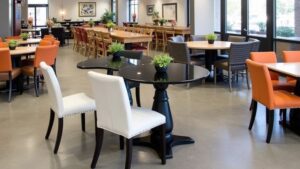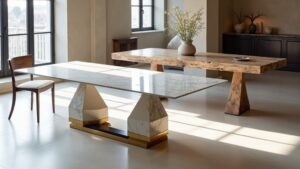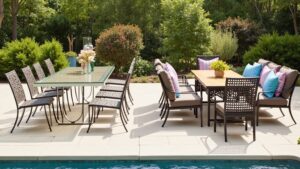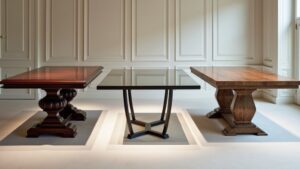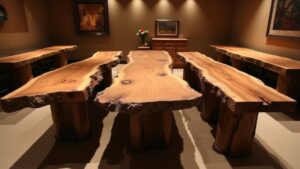Upcycling dining tables can yield stunning transformations that effortlessly blend style with practicality. A dated solid oak table can be modernized with soft neutral tones and a satin finish. A rustic drafting table may evolve into a chic family centerpiece, featuring a farmhouse-style surface. Meanwhile, a worn veneered table can achieve a charming farmhouse aesthetic, enhanced with light chalk paint. Each restoration offers unique character and functionality, inviting one to explore further inspiring possibilities.
Key Takeaways
- Transforming a solid oak table reveals its natural beauty through careful sanding and a modern color palette.
- A rustic drafting table becomes a chic family centerpiece with structural reinforcements and a wider, farmhouse-style tabletop.
- Worn veneered tables achieve a farmhouse aesthetic using light chalk paint and Danish oil to enhance natural tones.
- Upcycling dining tables offers cost-effective, durable solutions that improve functionality and aesthetic appeal in dining areas.
- Before and after transformations celebrate craftsmanship while preserving the original character of the furniture.
Transforming a Dated Solid Oak Table Into a Modern Dining Piece
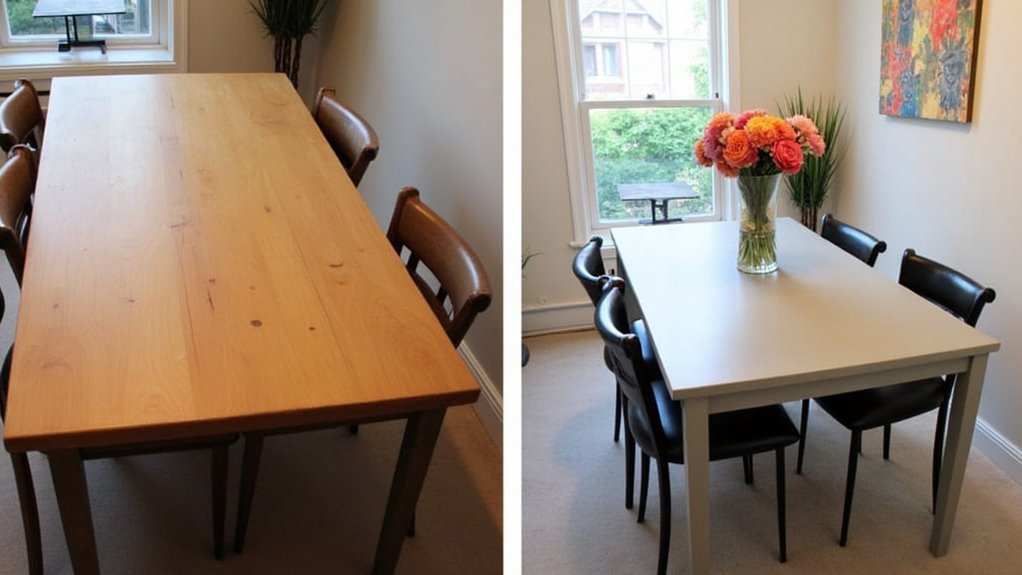
In the realm of interior design, a well-loved yet dated solid oak table can undergo a remarkable transformation into a striking modern dining piece.
The journey begins with careful material selection, where artisans pick boards of optimal thickness, ensuring durability. Fool-proof techniques for transforming outdated oak furniture can greatly simplify this process. Additionally, incorporating solid oak characteristics enhances the overall durability and longevity of the piece.
Preparation involves meticulous sanding using various grit levels to remove old finishes, revealing the oak’s natural beauty.
Meticulous sanding with varying grit levels unveils the oak’s exquisite natural beauty, setting the stage for a stunning transformation.
Color selection becomes pivotal; soft, neutral tones may be applied to legs, while a clear satin finish highlights the tabletop’s grain. Utilizing a natural oil finish can bring out the warmth and depth of the wood, complementing its unique patterns.
Finish techniques include decorative glazes that enrich warmth without overpowering, creating a harmonious balance.
Ultimately, these refinished tables transition from traditional to contemporary aesthetics, embodying elegance while preserving their rustic roots, making them captivating focal points in any dining space.
Revamping a Rustic Drafting Table Into a Chic Family Feasting Area
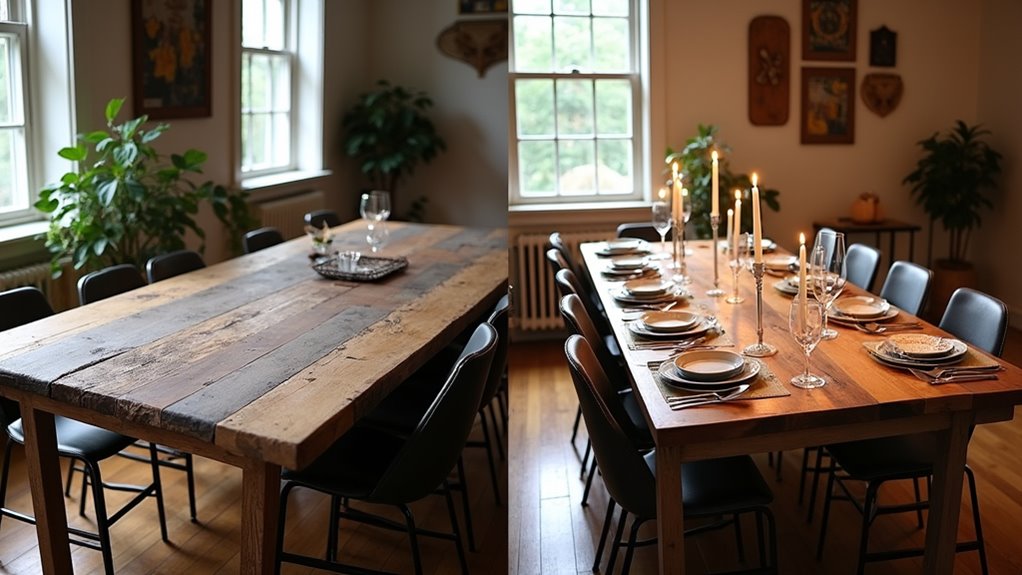
Transforming a rustic drafting table into a chic family feasting area breathes new life into a once-functional piece, reimagining its purpose and enhancing its aesthetic appeal.
The drafting table restoration begins with an assessment, determining necessary structural reinforcements for stability. Surface preparation follows, involving the careful stripping of old finishes and smoothing of the wood to reveal its inherent beauty. Emphasizing the importance of the wood’s natural tones and grain contributes to a richer visual experience, ensuring the final product is both stunning and practical. Additionally, utilizing durable materials, such as oak and walnut, ensures long-lasting functionality and scratch resistance in a busy family environment.
Customizing the tabletop may include crafting a wider, farmhouse-style surface, while integrating design elements to complement the home’s style. Final touches focus on durability and functionality, ensuring the table accommodates family-sized seating and adding protective features for daily use.
This family dining transformation marries rustic charm with modern requirements, celebrating both practicality and timeless style.
Updating a Worn Veneered Table With a Farmhouse Aesthetic
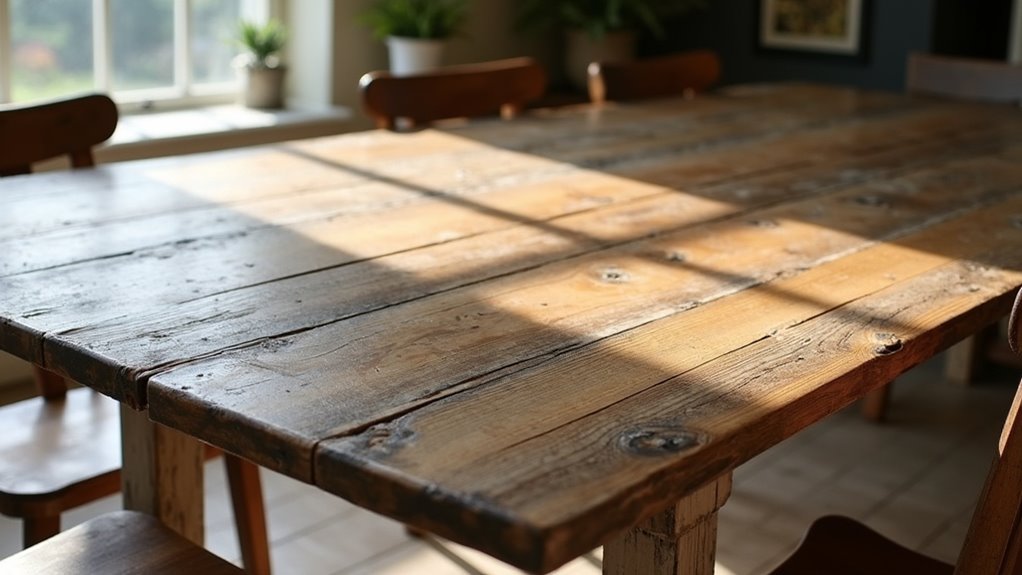
While many vie for the charm of a farmhouse aesthetic, updating a worn veneered table offers a practical pathway to achieving this timeless appeal without the hefty price tag of new furniture.
A meticulous veneered table restoration begins with thorough cleaning, using a TSP alternative to remove residues and odors. Attention to surface imperfections is vital; careful use of wood fillers tackles scratches and dents, preserving the elegance of the veneer.
For a classic farmhouse look, light chalk paint creates a matte finish, while Danish oil enhances natural wood tones. Additionally, incorporating elements like custom sizing options ensures that the transformed table fits seamlessly into any dining space.
Small design adaptations, like adding removable leaves or enhancing original features, contribute character.
This transformation not only revitalizes the table but marries rustic charm with modern functionality, embodying essential farmhouse design elements.
Articles on the same topic:
-
Top 10 Dining Tables in Dubai for All Styles
-
7 Best Commercial Dining Tables and Chairs for Your Business
-
Top 3 Best Selling Dining Tables for 2025
-
Top 3 Brown Jordan Dining Tables for Your Outdoor Area
-
Top 3 Lexington Furniture Dining Tables for Your Home
-
7 Stunning Rustic Log Dining Room Tables for Your Home



